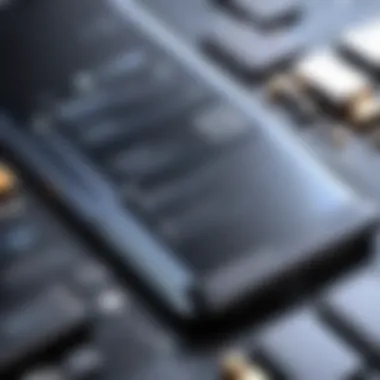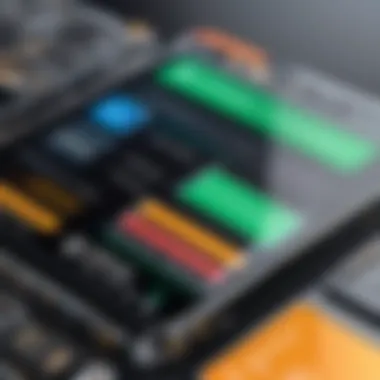Maximizing Your New Phone Battery's First Charge


Intro
Getting a new phone is often an exciting experience. With all the cutting-edge technology packed into these devices, the first charge of your phone battery can set the tone for its future performance. Many users may not realize that how they treat their battery during this initial charging period affects its longevity and efficiency. Today, we will peel back the layers on battery technology to find out how to best handle those first few hours with your new device.
It’s crucial to understand that battery technology has advanced significantly. The days of needing to let your phone drain completely before charging are largely behind us. Lithium-ion batteries, which power most modern smartphones, come with their own set of guidelines. Knowing the ins and outs of these guidelines ensures your new phone serves you well, avoiding unnecessary wear and tear.
In this article, we will dive into key performance metrics, usability aspects, and how to effectively care for your new battery from the very beginning. Let’s roll up our sleeves and dig into the nitty gritty of getting the best out of your new phone from day one.
Prologue to New Phone Batteries
Navigating through the world of new phone batteries can feel a bit like walking a tightrope. With all the advances in technology, knowing how to properly charge your brand-new device is more essential than ever. Taking care of your new battery from the get-go can lead to extended usage and improved longevity. An adequately charged battery not only powers your phone but connects you to the digital world around you. So, let’s dig into what makes phone batteries tick and why understanding them is crucial.
Understanding Lithium-Ion Technology
At the core of most modern smartphones is lithium-ion (Li-ion) technology. These batteries have dominated the landscape for several years, primarily due to their high energy density and relatively low self-discharge rates. This means they can store a lot of energy while not giving much away when not in use. A more curious fact about Li-ion batteries is their ability to handle numerous charge cycles, making them a worthy choice for daily phone use.
When your new phone arrives, it won’t be long before you notice some terms thrown around—like capacity, voltage, and cycle life. Capacity, measured in milliampere-hours (mAh), reflects how much energy the battery can hold. Voltage hints at performance potential. Cycle life refers to the number of complete charge and discharge cycles the battery can undergo before it starts to lose its effectiveness. Understanding these aspects can help you make educated decisions when charging your phone for the first time and beyond.
The Role of Battery Management Systems
Battery Management Systems (BMS) in smartphones serve to bridge the gap between human usage and complex battery chemistry. Think of a BMS as the brain behind the battery. It tracks important metrics such as voltage levels, temperature, and charge state. This oversight is significant in preventing overcharging, which could lead to battery degradation and even safety concerns.
Moreover, the BMS communicates with the smartphone’s operating system to optimize charging practices. For instance, some devices come with features that slow down charging as the battery reaches its peak capacity. This gradual approach is crucial, especially in the first charge. It ensures that the battery is nurtured rather than rushed.
"Nurturing a new battery is like planting a tree; how you tend to it at the beginning influences its growth and longevity."
In summary, understanding how lithium-ion technology works, alongside recognizing the pivotal role of battery management systems, can enhance your first charging experience. Armed with this information, you can not only prolong your battery's life but also ensure that your new phone meets your needs efficiently.
Preparing for the First Charge
When you first lay your hands on a new phone, that excitement is palpable. However, before diving into the world of apps and social media, there's a crucial step that shouldn’t be overlooked—preparing for the first charge. This stage sets the foundation for the battery's performance and longevity. Why is this preparation so significant? Essentially, it's about priming the battery to operate efficiently and maximize its lifespan.
Taking the time to properly prepare for this initial charge not only influences immediate performance but can also affect the overall health of the battery in the long run. Neglecting this process might lead to degraded performance, resulting in shorter battery life and inefficient usage over time. Consequently, understanding the steps involved in preparation can equip you with the knowledge to serve your device effectively.
Unboxing and Initial Inspection
Unboxing a new phone is often akin to opening a gift on your birthday. It's filled with anticipation, but it's not just about tearing off the packaging. The unboxing process is your first chance to assess the state of your new device and its battery.
- Check Components: After you unbox the phone, you should take a moment to verify that all components are present. This typically includes the phone itself, a charging cable, and possibly additional accessories like a case or headphones. Failing to check these items can complicate your first charging experience.
- Inspect for Damage: Examine the device diligently. Look for any signs of physical damage or defects. A seemingly minor scratch or dent could indicate larger problems beneath the surface, potentially affecting battery function.
- Condition of the Battery: Moreover, if the battery is removable, take a moment to check its condition. Look for any abnormalities that may indicate prolonged exposure to extreme temperatures or pressure during shipping.
By performing this thorough inspection, you’re ensuring readiness for what lies ahead. It pays to leave no stone unturned; even the smallest oversight could have cascading effects on performance.
Understanding Manufacturer Guidelines
Each phone manufacturer provides guidelines tailored to its specific devices and technologies. It may seem tedious to read through them, but doing so is invaluable. These recommendations often contain key insights into how to optimally charge your phone for the first time.
- Specific Charging Requirements: Manufacturers often outline distinct charging practices—for example, whether the phone should be charged completely or if it's acceptable to use it while charging. Adhering to these instructions can enhance the battery's efficiency.
- Charger Compatibility: An equally important aspect is using the right charger. Some manufacturers stress the need for original or OEM chargers to prevent damage. These chargers are designed to meet your phone's unique specifications, avoiding issues that might arise from third-party alternatives.
- First Charge Duration: Guidelines can also detail how long the first charge should last. There might be recommendations on maintaining the battery at specific charge levels, which can be crucial for optimal performance.


Thoroughly understanding and following these manufacturer guidelines can extend your phone's battery life significantly. Taking these steps seriously means you’re not just a user; you’re an informed owner who knows how to enhance their experience right from the get-go.
"Proper preparation prevents poor performance."
In summary, preparing for your phone’s first charge goes beyond just plugging it in. It involves a careful unboxing and a keen understanding of manufacturer guidelines, both working in tandem to ensure your new phone's battery gets off on the right foot. By recognizing the significance of these steps, you're already on the path toward efficient device use and a longer-lasting battery.
First Charge Considerations
The process of charging a new phone battery for the first time is not just a mundane activity; it’s a pivotal step in the device's journey to efficiency and longevity. While you might think throwing your new phone onto the charger is all you need, there’s more under the hood. Paying attention to the specifics can greatly influence the performance and lifespan of your battery. This section delves into several key aspects, shedding light on optimal charging duration, the pros and cons of wired versus wireless connections, and the significance of using original equipment manufacturer (OEM) chargers.
Optimal Charging Duration
When you first get your phone, you might wonder how long you should leave it charging. The popular belief suggests it’s good to charge your device until it reaches 100%, but that’s not entirely accurate.
Generally, for lithium-ion batteries, which most modern smartphones use, a full charge duration can vary, but around two to three hours is usually sufficient for a near-empty battery. However, it’s important to avoid letting your battery linger on the charger for too long after reaching 100%. Keep in mind that batteries can age prematurely if overcharged repeatedly.
To optimize charging:
- Disconnect after full charge: Unplugging right after the charge can help maintain battery health.
- Charge in intervals: If you use your phone extensively, consider short top-ups throughout the day rather than one lengthy charge. This approach helps in preventing deep discharges, which can be harmful over time.
Connection Method: Wired vs. Wireless
With a plethora of charging methods available, choosing between wired and wireless can be a head-scratcher. Generally:
- Wired Charging: Tends to be faster and more efficient. The connection here transfers power directly into your battery without any loss. Most likely, this will help you ease the tension when you need a quick top-up before heading out.
- Wireless Charging: While convenient, it can be comparatively slower. The power transfer often comes with a bit of energy loss, which means it might take longer. However, if you prefer quick grabs and don't mind slower speeds, wireless charging has become a popular choice for many.
A little tip: If you’re looking for speed, stick with wired charging; if convenience is your jam, then go for wireless.
Importance of Using OEM Chargers
Resorting to a third-party charger might seem like a budget-savvy option, but it’s a gamble that many prefer to avoid. Using OEM chargers is crucial for several reasons:
- Compatibility: OEM chargers are specifically made for your device, ensuring the voltage and current levels are appropriate. This helps in preventing unnecessary risks to the battery.
- Safety: Third-party chargers might lack important safety features, increasing the chances of overheating or, in the worst-case scenario, damaging your phone.
- Performance Guarantee: Using OEM chargers can lead to better charging speed and efficiency, optimizing your initial charging experience and influencing overall battery performance over time.
Careful consideration of these factors can make your first charging experience not just a routine task, but a crucial investment in the long-term health of your device. Making informed decisions concerning your phone’s first charge can lead to improved performance and undeniable satisfaction down the line.
Common Myths and Misconceptions
The Myth of Conditioning New Batteries
One of the most prevalent beliefs is that new batteries need to be conditioned before they can be used efficiently. Many think that the first few charges must be lengthy and that the battery should be fully drained before charging again. This is a throwback to older nickel-cadmium battery technology where conditioning was relevant, but lithium-ion batteries, which power modern smartphones, don't follow this rule.
Lithium-ion batteries are designed to handle partial discharges well. In fact, frequently depleting a battery to near zero can cause unnecessary strain.
- Tip: Charge the battery whenever possible without worrying about reaching an absolute full or emptied state.
- Benefit: This practice can lead to an overall longer battery lifespan.
And let's not forget, many individuals will cite anecdotes about needing to train their new battery, but these usually stem from misunderstandings rather than scientific backing. Instead of stressing about conditioning, focus on a balanced charging routine right from the start.


Understanding Deep Discharges and Full Charges
Another common misconception revolves around the notion of deep discharges versus full charges. There's a tendency among users to believe that letting their device completely run out of juice before charging it again is beneficial or somehow resets the battery life. This isn't the case with modern lithium-ion technology, which prefers a more nuanced approach to charging.
- Myth: Waiting until the battery is fully drained ensures better battery health in the long run.
- Truth: Modern batteries perform better when they are kept within a mid-range of charge.
- Consideration: Regularly allowing the battery to dip below 20% can lead to deterioration over time and may negatively influence the battery's effective capacity.
Battery life isn’t simply a measure of how much charge is left; it’s also about how often and well that charge is managed. Optimal practices suggest:
- Charging when below 30%: This can significantly aid in maintaining battery health.
- Avoiding constant full charges: Keeping a battery consistently at 100% isn’t ideal either and can stress the battery over time.
"It’s about balance: Regular, shallow charges are your best friend. Never let it run dry too many times."
Understanding the truth about battery management can do wonders for extending overall battery life and ensuring a reliable experience with your phone. When professionals arm themselves with correct knowledge about battery myths, they can make informed choices to support their devices effectively.
Impact of Environmental Factors
When delving into the nuances of a phone battery's first charge, one cannot overlook the impact of environmental factors. The surrounding conditions can significantly affect not just the charging process, but also the overall longevity and performance of lithium-ion batteries. Understanding this relationship is vital for IT professionals and tech enthusiasts alike, as even minor changes in environment can lead to variations in battery efficiency.
Temperature and Its Effects on Charging
Temperature plays a crucial role in determining how well a battery charges and discharges. Ideally, lithium-ion batteries perform best in a temperature range of around 20°C to 25°C (68°F to 77°F). Charging a battery in excessively high or low temperatures can lead to several issues.
- High Temperatures: When a battery is charged in a hot environment, it can lead to overheating. This not only slows down the charging process but may also trigger protective mechanisms, preventing the battery from reaching its full capacity. Long-term exposure to heat can degrade battery life significantly, often leading to swelling or, in severe cases, rupture.
- Low Temperatures: On the flip side, charging a battery in cold conditions can lead to sluggish performance. Chemical reactions within the battery slow down, resulting in inefficient charging. Users might notice that their device charges slower than normal, or sometimes, it may struggle to charge at all.
Being mindful of where and how you charge your device can make a world of difference. For example, avoiding leaving your phone in direct sunlight or in frigid conditions (like a car in winter) can help maintain optimal battery health.
"Batteries and temperature are like chalk and cheese; when they're too far apart, they just don't get along."
Humidity Considerations
Humidity is another environmental factor that should not be brushed off lightly. High levels of moisture in the air can lead to condensation inside the phone. This moisture can corrode internal circuits and disrupt the battery's performance. While many modern devices are designed to withstand a certain degree of humidity, prolonged exposure can still be detrimental.
- High Humidity: Environments with high humidity may encourage short circuits within the battery or other electronic components. This not only hampers the charging efficiency but can also lead to safety hazards if left unchecked.
- Low Humidity: Conversely, extremely dry conditions can influence static electricity levels, which can potentially affect the battery's charging process. While not as critical as high humidity, it's still wise to protect your device from very dry environments.
Maintaining a balanced atmosphere can create a safe charging ecosystem for your devices. Taking care to store your phone in a place where humidity is regulated can extend battery life and prevent unforeseen damage.
In summary, both temperature and humidity have significant implications for battery performance during the first charge. Recognizing and addressing these environmental factors can lead to a more successful initial charge and, ultimately, a healthier battery life.
First Charge Performance Monitoring
In the realm of modern smartphones, the initial charging experience can set the tone for your device’s long-term performance. First charge performance monitoring is not merely a technical consideration; it's an insightful approach to understanding how well your battery will serve you in its lifespan. Keeping a close watch on battery health indicators and evaluating charge cycles can benefit both tech enthusiasts and IT professionals alike. This section delves into effective strategies for monitoring battery performance from the very first charge.
Tracking Battery Health Indicators
Monitoring battery health indicators is akin to keeping a finger on the pulse of your device's vitality. It can offer valuable insights into how effectively your battery holds a charge and ages over time. Here are key components to keep an eye on:
- Voltage Levels: Regular checks on the battery's voltage can reveal charging issues. A significant dip may indicate problems with the battery or its charging mechanism.
- Charge Cycles: Understanding how charge cycles impact battery life is crucial. A charge cycle occurs when the battery changes from fully charged to fully discharged and back again. Monitoring this can inform you on optimal usage patterns.
- Capacity Readings: Battery capacity diminishes over time. Using apps or system settings that display current capacity vs. original capacity can allow you to assess when it might be time for a replacement.


By paying attention to these indicators, users can take proactive measures if they see warning signs.
"An ounce of prevention is worth a pound of cure." - Benjamin Franklin
Evaluating Charge Cycles
Evaluating charge cycles is an essential practice that plays a significant role in the long-term sustainability of a phone's battery. Charge cycles reflect how many times a battery has gone through a complete discharge and recharge. Here are some essential aspects to consider:
- Full Versus Partial Cycles: It's often beneficial to understand the difference between a full cycle and partial cycles. Using your device through its entire charge from 100% down to as low as 20% constitutes one complete cycle. However, if you charge it to 80% from 20% and later top it back to 100%, it doesn't count as a full cycle. This information aids in establishing effective charging routines.
- Connection Methods: Different charging methods can influence the cycles. Wired and wireless charging often perform differently. Wired charging tends to be quicker, which can be a double-edged sword; it might enhance efficiency, but it can also lead to quicker wear if used excessively.
- Impact of Frequent Charging: Cumulatively, multiple partial charges can add up to a full cycle. Users should balance their charging habits. Frequent charging in small bursts could make it easier to achieve the needed cycles without extensive depletion, proving beneficial over time.
Long-Term Battery Maintenance
Long-term maintenance of your phone battery plays a crucial role in maximizing its lifespan and maintaining optimal performance. This segment aims to shed light on the best practices that ensure your battery remains healthy and efficient as the months roll on.
Battery maintenance is not just about the initial charge; it’s about the ongoing relationship with your device. Understanding how to handle your battery properly will help mitigate common issues like rapid aging or unexpected shutdowns. Here are some elements to consider:
- Routine Checks: Regularly monitor your battery's health using built-in tools or battery management apps. This can help catch issues before they escalate.
- Avoid Extreme Conditions: Consistently exposing your phone to extreme temperatures can wreak havoc on its battery. Keeping it in environments that are too hot or too cold can lead to irreversible damage.
- Periodic Calibration: Over time, your battery's reading may not be accurate. Calibrating it once every few months will help maintain accuracy in how much charge is actually available.
Establishing Charging Routines
Setting a consistent charging routine is fundamental. It's like going to the gym; the more consistent you are, the better results you’ll see. Aim to charge your phone overnight but avoid keeping it plugged in for unnecessarily long durations after it has reached 100%. This practice can generate excess heat which may degrade battery life over time.
Here are some suggestions to establish a healthy charging routine:
- Charge Between 20% and 80%: Keep your battery level between 20% and 80% during daily usage. This range minimizes stress on the battery and may prolong its lifespan.
- Nighttime Charging: Plugging it in overnight is acceptable, but try to ensure it doesn't exceed 100% for too long.
- Use Power Saving Modes: Most smartphones have built-in features that help conserve battery, especially when you're using it heavily.
A smart charging regimen not only extends your battery life, but it also enhances your device’s overall performance.
Understanding Fast Charging vs. Standard Charging
The choice between fast charging and standard charging often hinges on convenience versus care. Fast charging can be a lifesaver when you’re pressed for time; however, it can generate a bit more heat, which isn’t ideal for battery health in the long run.
To make an informed decision:
- Fast Charging: This method can replenish your battery to around 50% in just 30 minutes. While convenient, it may increase wear on the battery due to higher temperatures produced during the process.
- Standard Charging: Though slower, standard charging tends to be gentler on the battery. For most users, this is sufficient and helps maintain the unit’s longevity.
Ultimately, your choice should reflect your needs. If you often find yourself in need of a quick charge, then fast charging is helpful, but balance it out with sufficient periods of standard charging to mitigate potential impacts.
In summary, maintaining your phone battery is an ongoing endeavor. From establishing consistent routines to balancing fast and standard charging methods, each facet plays a role in ensuring that your battery thrives for as long as possible.
End
Recap of First Charge Insights
In the world of new phone batteries, specifically lithium-ion types, initial charging practices play a significant role in establishing a healthy lifespan. Here are some key takeaways:
- Adhere to Manufacturer Guidelines: Always follow the instructions provided by the manufacturer. These guidelines are tailored to the specific battery chemistry and design, ensuring users can avoid pitfalls that might lead to reduced efficiency or lifespan.
- Charge Duration Matters: Charging your device for a few hours upon the first use is ideal, as it allows the battery to acclimate. Avoid disconnecting it prematurely, as this could impact its memory cycle.
- Monitor Environmental Conditions: It's essential to take into account temperature and humidity, as these factors can affect the charging efficiency and battery health over time. Keeping your phone in moderate conditions helps ensure optimal performance.
- Use the Right Charger: Many devices come with proprietary chargers that cater to their specific energy needs. Employing OEM chargers will maintain battery integrity and prevent potential damage.
Future Trends in Battery Technology
Looking ahead, battery technology constantly evolves, promising exciting innovations:
- Solid-State Batteries: These batteries offer higher energy densities and enhanced safety features compared to traditional lithium-ion batteries. They have the potential to revolutionize how quickly and efficiently we charge our devices.
- Fast Charging Developments: As demand for quick charging grows, manufacturers are exploring advanced methods that reduce charging time significantly without compromising battery health.
- Smart Battery Management Systems: Future devices might integrate more sophisticated battery management systems that learn user habits, optimizing charging patterns accordingly. This could lead to improved battery life spans in the long run.
- Sustainability Advances: As technology progresses, manufacturers face increasing pressure to reduce their environmental footprint. Expect to see a rise in sustainable practices for battery production and recycling in the coming years.
Endeavoring to stay informed about these trends and best practices can be advantageous not only for optimizing your device's performance but also for contributing to a more sustainable future. By understanding the nuances of your battery's first charge, you lay down a robust foundation for long-lasting usage.



